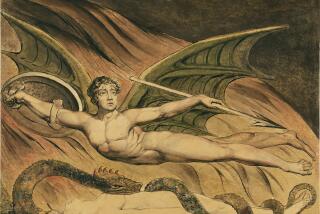Michael Demson’s graphic novel of Shelley’s radical ‘Mask of Anarchy’
- Share via
Here’s some reading for the rest of the Fourth of July holiday weekend: Michael Demson’s graphic history “Masks of Anarchy” (Verso: 128 pp., $16.95) traces a connection between Percy Bysshe Shelley’s poem “The Mask of Anarchy,” written in 1819 as a response to the “Peterloo Massacre” in Manchester, England, and the life of Pauline Newman, a New York labor organizer of the early 1900s who once worked at the Triangle Shirtwaist Company.
It’s a fascinating book for all sorts of reasons, not least its portrayal of America’s ongoing antipathy toward immigrants, which, of course, remains very much in the news.
A century ago, Demson notes, newspapers regularly published comics “that were viciously reactionary.… In one … the Statue of Liberty scowls as ships, one labeled ‘Refuse’ and ‘European Garbage Ship,’ dump immigrants on her feet.… In another, Uncle Sam stands at the gateway to America, pinching his nose at the arrival of a ragged Jewish immigrant, who carries bags labeled ‘Poverty,’ ‘Superstition,’ ‘Disease,’ ‘Anarchy,’ and ‘Sabbath Desecration.’”
What Demson is saying is that the more things change, the more they don’t, and that our political lives can be read as part of a lineage, both good and bad. “Masks of Anarchy” is all about such lines and how they operate, across continents and centuries, even up to the present day.
Newman, after all, found in Shelley’s political poems an inspiration, a call to arms, reciting them in reading circles and in labor meetings, using his language, his engagement, to provoke her own sort of change. Called a “new Joan of Arc” by the New York Times in 1907, she fought to end child labor and establish the eight-hour workday, as well as “the right to organize, the regulation of fire safety and safe working conditions, and a minimum wage.”
All of this can make for tricky material in a comic, but Demson pulls it off because of his attention to narrative. Moving back and forth from Shelley to Newman, he creates a delicate weave, playing one story off the other, searching out the commonalities they share.
“In Shelley’s day,” he writes, “it was the king, lords, and landowners who robbed and brutalized the working classes. In America, it was the factory owners who extorted the poor, bought off politicians, judges, the police, inspectors, and did everything they could to stop union organizers.”
Shelley was a radical, suspected of “Blasphemy! … Treason … Sedition!!!” His poem “The Devil’s Walk” satirized the wealthy and the privileged, accusing them of being in league with Satan, without whom they would not thrive. “And they thrive well,” he wrote, “who from the poor, / Have snatched the bread of penury, / And heap the houseless wanderer’s store, On the rank pile of luxury …”
“The Mask of Anarchy” is perhaps even more radical, a cry of outrage that concludes: “Rise like lions after slumber / In unvanquishable number — / Shake your chains to earth like dew / Which in sleep had fallen on you — / Ye are many — they are few.”
Left unpublished until a decade after the poet’s death, it is a call for nonviolent resistance that influenced Thoreau and Gandhi, as well as Newman, and speaks directly to Shelley’s contention that “poets are the unacknowledged legislators of the world.”
“Masks of Anarchy” is not a perfect project; given its focus on the exploited, it’s ironic that the illustrator, Summer McClinton, has not been given co-author status, despite the power of her documentary-style illustrations, which bring an essential immediacy to the book. Then, there’s historian Paul Buhle’s introduction, which gives new meaning to the words “overstated” and “patronizing.”
But in the end, that’s a minor criticism; we don’t read a book for the introduction, after all. The real strength of “Masks of Anarchy” lies in the telling … and in the sense that, 200 years after Shelley and a century after Newman, we still have a long way to go.
ALSO:
Fantagraphics co-publisher Kim Thompson dies of lung cancer ...
Steven T. Seagle, Teddy Kristiansen graphic novel probes ‘Genius ...
Joe Ollmann’s graphic novel ‘Science Fiction’ tackles mystery of love
More to Read
Sign up for our Book Club newsletter
Get the latest news, events and more from the Los Angeles Times Book Club, and help us get L.A. reading and talking.
You may occasionally receive promotional content from the Los Angeles Times.








